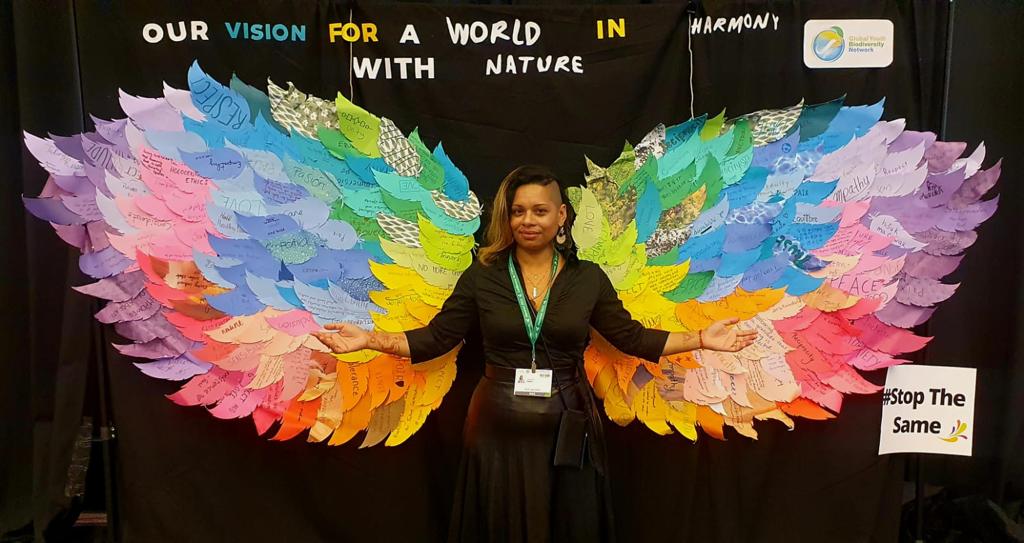
23, January 2023
COP15 and the Rights of Nature
We were thrilled to be represented at COP15 in Montreal last month by Ally Pimor, Director of Corporate Governance at Earth Law Center and Representative of Nature on our board. Ally was talking about Nature Rights, sharing the experience of having Nature on our board and inviting others to do the same. In light of the conference, we spoke to Ally about the conference and Nature’s Rights.
Firstly, what is COP15?
COP is short for the ‘Conference of the Parties’. The two best-known COPs are the one that focuses on the climate crisis (the most recent one, COP26, took place in Glasgow in 2021) and one that focuses on the conservation of biodiversity, which is the one I just attended. COP15 was held in two locations: Kunming (China) and Montreal (Canada). COP15 was the 15th meeting of the governing body tasked with overseeing the implementation of the Convention on Biological Diversity (CBD).
The Convention on Biological Diversity (CBD) was inspired by the world community's growing commitment to sustainable development. It represents a dramatic step forward in the conservation of biological diversity, the sustainable use of its components, and the fair and equitable sharing of benefits arising from the use of genetic resources.
The CBD is a significant legally binding international agreement on the protection of the environment and the conservation of biodiversity. The great majority of nations that have signed up to it since it came into force in 1993 are under a duty to safeguard biodiversity. They are tasked with promoting policies that prevent further damage and reverse the loss of biodiversity. Since 2000, the COP for the CBD is held every two years, and at the meeting signatory nations agree to new policies, goals and targets for the implementation of the CBD.
How is COP15 different to the other COPs?
Although the CBD itself is legally binding, the decisions of the COP – goals, targets – are not legally enforceable as such, and are instead subject to the discretion of each nation in the way the policies are formulated and implemented at the national level.
We are facing an unprecedented threat to the sustainability of life on planet Earth. Human activities have caused sever biodiversity loss, including species extinction, the deterioration of ecosystems, animal and plant communities. As Callie Broaddus, Founder & Executive Director at Reserva: The Youth Land Trust states: “The planet’s biodiversity is our circulatory system, and at the moment, we are bleeding out.”. It is within our responsibility and our means to stem this bleeding: we are the first responders and we have to act now.
Given our current state of emergency, this COP15 was significant because it has set out the goals and targets for biodiversity conservation, loss reversal and restoration for the next ten years, with the post-2020 Global Biodiversity Framework (BGF) outlining the vision for humanity to live in harmony with Nature by 2050.
What, if anything, does the COP15 agreement do to recognise the Rights of Nature?’
The Kunming-Montreal Global Biodiversity Framework was adopted by nearly 200 countries at COP-15. It promotes the Rights of Nature and supports 30x30, which is a commitment to preserve 30 per cent of the planet’s land and sea by the year 2030.
What was Earth Law Center campaigning for at COP15?
ELC attended the COP with the intention to campaign for the adoption of the rights of Mother Earth within the Global Biodiversity Framework (GBF), which is a plan that determines key action points, goals, targets and objectives for the reversal of biodiversity loss, restoration of ecosystems and protection of indigenous rights. As the GBF fosters a vision of humanity living in harmony with Nature by 2050, ELC was present to ensure that this vision is not just human-centred but also Nature focused, i.e. eco-centric. Given that the imbalance that we experience on Earth across interlaced and complex levels is primarily caused by human actions, the inclusion of Rights of Nature/Mother Earth is pivotal to enhancing and developing ethics of care and human responsibility in humanity’s governance culture, in order to be in the service of planetary health and wellbeing.
Whilst it may be anthropomorphising and gendering Nature, the adoption of Mother Earth language can be helpful in repairing the relationship between humanity and the Earth as a whole. Many indigenous peoples do not distinguish between being human and being Nature. However, in a westernised, Euro-centric paradigm, there is a separation between humanity and Nature that has led to human destructive behaviour.
How integral to a reversal of biodiversity loss is legal recognition of the Rights of Nature?
Biodiversity is Nature – it is an integral part, an essential element and a diverse expression of Nature. For as long as Nature is deemed a commodity, extracted and pillaged for its extractive value as capital, biodiversity loss and ultimate extinction are inevitable.
The inclusion of the Rights of Nature and Rights of Mother Earth in the GBF section on ‘different value systems’ highlights this paradigm, as an alternative to the status quo of maximizing short-term wealth at the expense of the environment. Therefore, the use of Mother Earth Language would give Nature a tangible form in human minds, which would:
- Promote a sense of responsibility and care towards our planet as the source of all life;
- Nurture an interconnected, interdependent and interrelated mind-frame in how humanity relates to Nature as a whole; considering Nature as a subject of rights to be respected, rather than an object to be owned, used and capitalised.
- Enhance the voice, rights and standing of Nature across national legal, economic and political systems.
The recognition of the Rights of Nature / Mother Earth gives Nature its rightful place as an entity with a right to thrive – and Nature includes humanity. So this would also mean rethinking human relations to each other, especially in relation to the protection and respect of indigenous peoples who have an intrinsic connection to and innate knowledge of their home and ancestral lands; and whose guardianship and stewardship roles and wisdom are crucial today.




